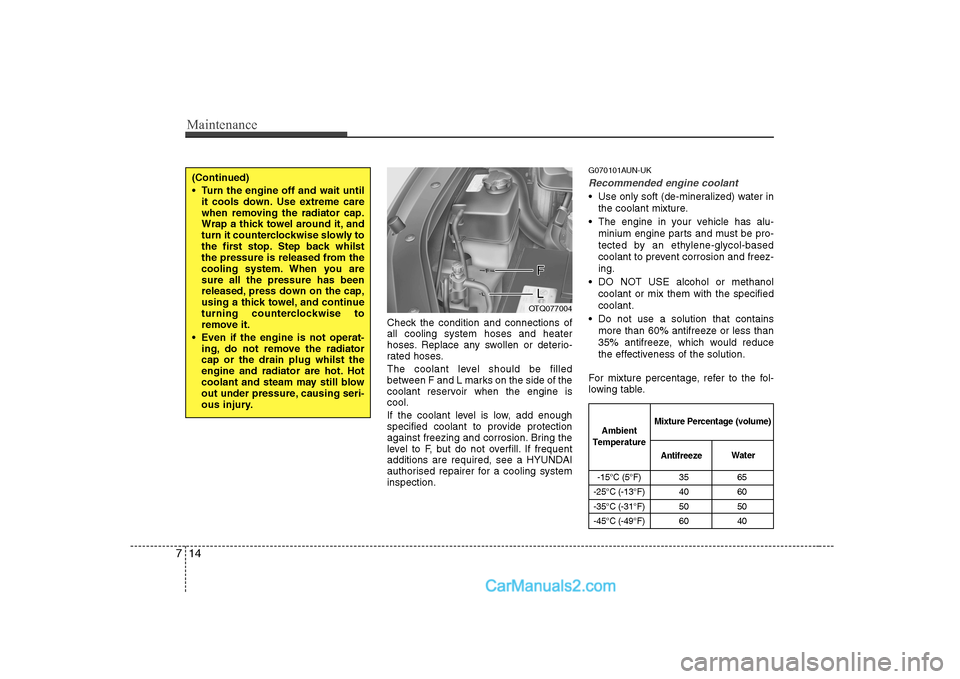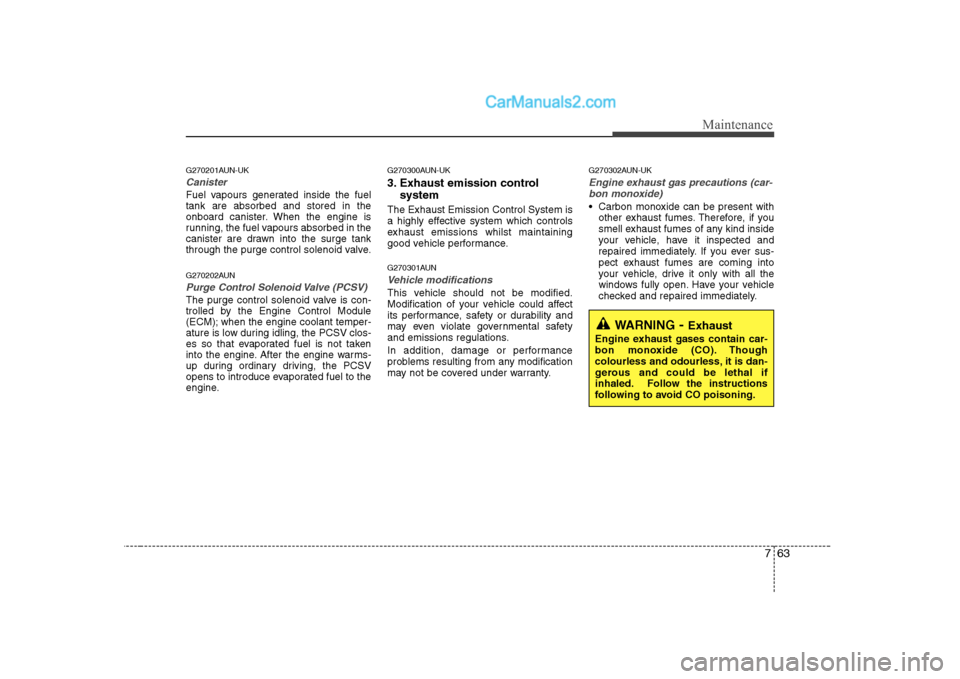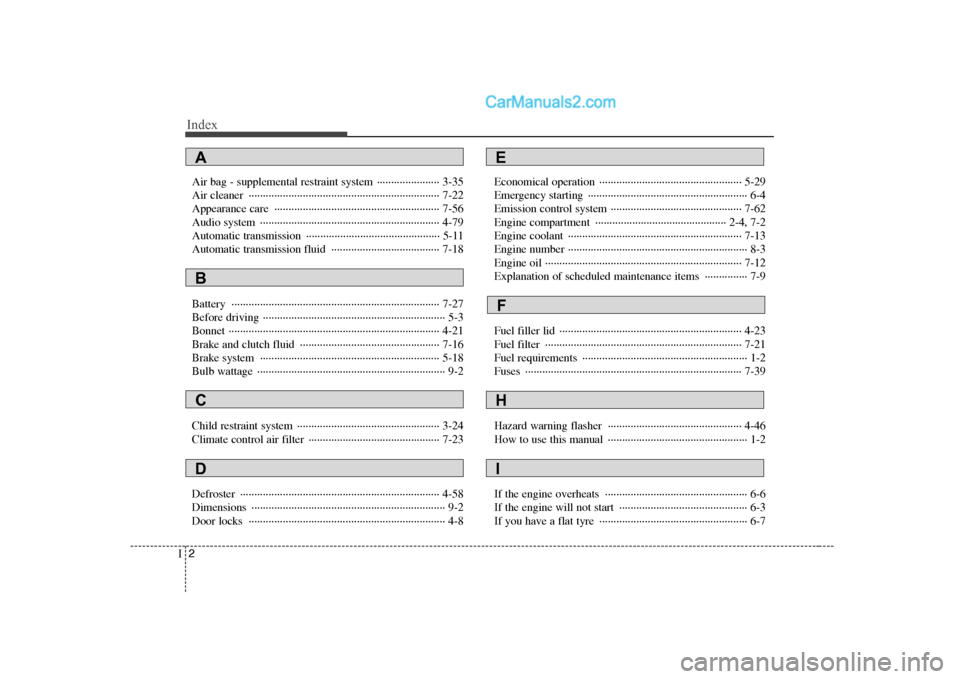Page 233 of 303

Maintenance
14
7
Check the condition and connections of all cooling system hoses and heater
hoses. Replace any swollen or deterio-
rated hoses.
The coolant level should be filled
between F and L marks on the side of the
coolant reservoir when the engine iscool.
If the coolant level is low, add enough
specified coolant to provide protection
against freezing and corrosion. Bring the
level to F, but do not overfill. If frequent
additions are required, see a HYUNDAI
authorised repairer for a cooling systeminspection. G070101AUN-UK
Recommended engine coolant
Use only soft (de-mineralized) water in
the coolant mixture.
The engine in your vehicle has alu- minium engine parts and must be pro-
tected by an ethylene-glycol-based
coolant to prevent corrosion and freez-ing.
DO NOT USE alcohol or methanol coolant or mix them with the specifiedcoolant.
Do not use a solution that contains more than 60% antifreeze or less than
35% antifreeze, which would reduce
the effectiveness of the solution.
For mixture percentage, refer to the fol-
lowing table.
OTQ077004
-15°C (5°F) 35 65
-25°C (-13°F) 40 60
-35°C (-31°F) 50 50
-45°C (-49°F) 60 40
Ambient
Temperature Mixture Percentage (volume)
Antifreeze Water
(Continued)
Turn the engine off and wait until
it cools down. Use extreme care
when removing the radiator cap.
Wrap a thick towel around it, and
turn it counterclockwise slowly to
the first stop. Step back whilst
the pressure is released from the
cooling system. When you aresure all the pressure has been
released, press down on the cap,
using a thick towel, and continue
turning counterclockwise to
remove it.
Even if the engine is not operat- ing, do not remove the radiatorcap or the drain plug whilst the
engine and radiator are hot. Hot
coolant and steam may still blow
out under pressure, causing seri-
ous injury.
Page 234 of 303
715
Maintenance
G070200AEN-UK Changing the coolant
Have coolant changed by a HYUNDAI
authorised repairer according to the
Maintenance Schedule.
WARNING - Radiator cap
Do not remove the radiator cap when the engine and radiator are
hot. Scalding hot coolant and
steam may blow out under pres-
sure causing serious injury.
OTQ077005
CAUTION
Put a thick cloth or fabric around the radiator cap before refilling the coolant in order to prevent the
coolant from overflowing into engine parts such as generator.
WARNING - Coolant
Do not use radiator coolant or antifreeze in the washer fluid
reservoir.
Radiator coolant can severely obscure visibility when sprayed
on the windscreen and may
cause loss of vehicle control or
damage to paint and body trim.
Page 282 of 303

763
Maintenance
G270201AUN-UK
Canister
Fuel vapours generated inside the fuel tank are absorbed and stored in the
onboard canister. When the engine is
running, the fuel vapours absorbed in the
canister are drawn into the surge tank
through the purge control solenoid valve.
G270202AUN
Purge Control Solenoid Valve (PCSV)
The purge control solenoid valve is con-
trolled by the Engine Control Module
(ECM); when the engine coolant temper-
ature is low during idling, the PCSV clos-
es so that evaporated fuel is not taken
into the engine. After the engine warms-
up during ordinary driving, the PCSV
opens to introduce evaporated fuel to the
engine.G270300AUN-UK
3. Exhaust emission control
system
The Exhaust Emission Control System is
a highly effective system which controls
exhaust emissions whilst maintaining
good vehicle performance.
G270301AUN
Vehicle modifications
This vehicle should not be modified.
Modification of your vehicle could affect
its performance, safety or durability and
may even violate governmental safety
and emissions regulations.
In addition, damage or performance
problems resulting from any modification
may not be covered under warranty. G270302AUN-UK
Engine exhaust gas precautions (car-
bon monoxide)
Carbon monoxide can be present with other exhaust fumes. Therefore, if you
smell exhaust fumes of any kind inside
your vehicle, have it inspected and
repaired immediately. If you ever sus-
pect exhaust fumes are coming into
your vehicle, drive it only with all the
windows fully open. Have your vehicle
checked and repaired immediately.
WARNING - Exhaust
Engine exhaust gases contain car-
bon monoxide (CO). Though
colourless and odourless, it is dan-
gerous and could be lethal if
inhaled. Follow the instructions
following to avoid CO poisoning.
Page 291 of 303
95
Specifications
Lubricant Volume Classification13 l (11.43 Imp. qts.)
Coolant 10.2
l (8.97 Imp. qts.) Mixture of antifreeze and water
10 l (8.79 Imp. qts.) (Ethylene glycol base coolant for aluminium radiator)
7.1 l (6.24 Imp. qts.)
Brake fluid
0.7~0.8 l (0.61~0.70 Imp. qts.)FMVSS116 DOT-3 or DOT-4
The temperate zone (-30°C ~ 30°C) : API GL-4 (SAE 90)
Rear axle oil1.8~2.4 l(1.58~2.11 Imp. qts.)The torrid zone (30°C ~ ) : API GL-4 (SAE 140)
The frigid zone ( ~ -30°C) : API GL-5 (SAE 80)
Fuel 75 l(16.49 Imp. gal.) -
Diesel engine
Petrol engine
Diesel engine Petrol engineWagon
Va n
Page 301 of 303

Index
2
I
Air bag - supplemental restraint system ······················ 3-35
Air cleaner ··································································· 7-22
Appearance care ·························································· 7-56
Audio system ······························································· 4-79
Automatic transmission ··············································· 5-11
Automatic transmission fluid ······································ 7-18
Battery ········································································· 7-27
Before driving ································································ 5-3
Bonnet ·········································································· 4-21
Brake and clutch fluid ················································· 7-16
Brake system ······························································· 5-18
Bulb wattage ·································································· 9-2
Child restraint system ·················································· 3-24
Climate control air filter ·············································· 7-23
Defroster ······································································ 4-58
Dimensions ···································································· 9-2
Door locks ····································································· 4-8 Economical operation ·················································· 5-29
Emergency starting ························································ 6-4
Emission control system ·············································· 7-62
Engine compartment ·············································· 2-4, 7-2
Engine coolant ····························································· 7-13
Engine number ······························································· 8-3
Engine oil ····································································· 7-12
Explanation of scheduled maintenance items ··············· 7-9
Fuel filler lid ································································ 4-23
Fuel filter ····································································· 7-21
Fuel requirements ·························································· 1-2
Fuses ············································································ 7-39
Hazard warning flasher ··············································· 4-46
How to use this manual ················································· 1-2
If the engine overheats ·················································· 6-6
If the engine will not start ············································· 6-3
If you have a flat tyre ···················································· 6-7
A
B
C
D
E
F
H
I
Page:
< prev 1-8 9-16 17-24